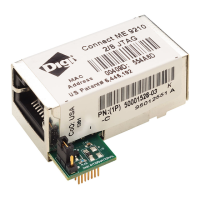Latency tuning Achieving deterministic IP performance
Digi Connect Family and ConnectPort TS Family
130
Achieving deterministic IP performance
Use the following recommended process to achieve deterministic IP networking behavior. This
process uses Digi commercial off-the-shelf firmware and hardware, and does not use not any
specialized products that specifically reduce latency. By following this process, you can define and
address latency issues at multiple levels in your network and application. To achieve deterministic IP
networking behavior:
1. Determine the characteristics of your application, in terms of traffic pattern and amount of
traffic generated.
2. Determine the latency budget and the type of latency in which you are interested.
3. Depending on the results produced in steps 1 and 2 and if applicable, optimize the physical
layer.
4. Depending on the results produced in steps 1, 2, and 3 and if applicable, optimize the network
and transport layer.
5. Depending on the results produced in steps 1, 2, 3, and 4 and if applicable, optimize the
application layer.
Best-case scenario for achieving deterministic IP networking
behavior
The best-case scenario for achieving deterministic IP networking behavior with Digi firmware and
hardware is a unidirectional master-slave application running over an isolated Ethernet network that
is built around Ethernet switches instead of Ethernet hubs. In other words, a network that eliminates
unnecessary traffic and minimizes Ethernet collisions.
Step 1: Determine the characteristics of your application
Consider your application in terms of traffic pattern and amount of traffic generated.
n What is the main purpose of the application, and the primary activities?
n What is the traffic pattern: Is it peer-to-peer or master-slave application?
n What is the amount of traffic generated (x bytes every y minutes): How much data is being
transmitted from and received by the application, and over what amount of time? For example,
200 bytes of data sent over 500 milliseconds.
Step 2: Determine the latency budget and type of latency
Determine the latency budget and type of latency in which you are interested. Identifying the latency
budget for your application involves defining what latency means for your network and the application
running on it. Consider how much latency is acceptable and whether the latency is one-way or round-
trip. This latency budget influences how much optimization you may need to perform at the physical,
data link/network, and application layers.
Step 3: Optimize the physical layer
Depending on the results produced in steps 1 and 2, optimize the physical layer; that is, address the
physical-layer characteristics that can affect latency.

